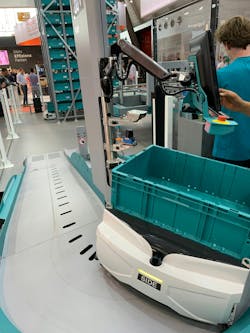Two technologies that have risen to prominence in industrial settings over the past few years are light detection and ranging (LiDAR) and IO-Link. The discussion, popularity and implementation of both continue to rise. Aaron Rothmeyer, manager, market product manager, at SICK, explains why.
Q: For those who might be new to the technology, could you explain in simple terms what LiDAR is, what makes it a unique and powerful sensing method that transcends its origins in surveying and how it compares to other technologies like radio detection and ranging (radar) or other types of vision and sensing devices?
A: In simple terms, any LiDAR-based technology is nothing more than a collection of distance measurements obtained using light, most commonly generated using lasers. The distance measurements are calculated by bouncing several pulses of light off of a target and using the constant speed of light to calculate the distance travelled by each pulse. These distances are usually accumulated and reported in a group known as a point cloud.
This technology was first widely employed in surveying and academic pursuits but was quickly adapted to industrial applications back in the mid-1900s. SICK actually pioneered this adaptation by using the technology to create safety-rated sensors that used LiDAR to detect people present in dangerous environments (Figure 1). Since then it’s really grown to become a staple in industrial automation, especially in mobile robotics but also in warehouse logistics and machine design.
Just like any other sensing technology, LiDAR has its strengths and weaknesses. In general, it has great resolution at longer distances even in nasty environments. Where cameras, for example, can be affected by ambient light, LiDAR generates its own infrared pulses so it can operate completely fine in total darkness. Radar can do this, too, but the technology is also typically lower-resolution than the “laser precision” that LiDAR provides. The downside to all this power has traditionally been cost, but that has also changed quite a lot over the last few years, enabling sensors like the TiM100 to be used in an increasing number of applications.
Q: What role does IO-Link, an open communication protocol, play in simplifying or complicating the integration of sensors? Are there specific IO-Link features that are particularly helpful?
A: The advantages of IO-Link are quite clear as the protocol enables various “smart sensing” capabilities on low-cost sensors. Because it communicates right over the standard transistor-based digital output wires, it doesn’t require any extra cabling, so both cost and complexity are minimized. As a matter of fact, I’m certain many customers are using IO-Link sensors right now and don’t even realize it! Often, these sensors can be fully configured and employed just using the buttons or display on the sensor.
However, tapping into the sensor using an IO-Link gateway or programming tool unlocks some great features that elevate a basic sensor to a smart sensor. For example, most current versions of IO-Link support some level of cloning where the configuration of a sensor can be stored remotely and loaded onto a blank sensor if anything should happen to the original. This can be very helpful for minimizing unplanned downtime. The IO-Link connection also often unlocks access to more advanced functions. For example, the TiM100 sensor uses IO-Link to allow users to configure zones or areas of interest so that an object entering those zones will trigger one of the two digital outputs.
Q: Can you share some examples of use cases that have integrated IO-Link and LiDAR sensing in industrial applications? What made these integrations go smoothly?
A: As I mentioned, one of the most common use cases where we see IO-Link based LiDAR sensors being used is in logistics automation. As warehouses employ such extraordinary lengths of conveyors, there is often a need to detect boxes or objects as they travel along the conveyors, and sometimes, too, detecting when objects are where they aren’t supposed to be, such as overhanging or fallen packages (Figure 2).
Since these sensors are often numerous and spread out over hundreds or thousands of feet, the IO-Link protocol allows users to connect several sensors to a single gateway and then run a single, usually Ethernet, cable back to their controller. This function alone really makes the integration go much smoother, but it also makes troubleshooting easier down the line. Since each sensor is addressable, they can be accessed remotely and often identified individually by, say, flashing the lights on the sensor to quickly find the one in question.
Get your subscription to Control Design’s daily newsletter.
Q: What are some of the common misconceptions surrounding the implementation of IO-Link LiDAR sensors?
A: The biggest misconception is that they don’t exist! LiDAR has a reputation of being expensive and complex. That’s not without merit; in many cases, LiDAR can be very complex to integrate and certain high-end models can cost several thousand dollars. SICK has been doing LiDAR long enough, though, to recognize that not every customer needs to have a full 3D point cloud for their application and not every customer has a software engineer standing by to work with raw Ethernet data. What we’ve done is “sensorize” LiDAR by making it smaller, lower cost and easy to integrate. IO-Link is a big part of that for all of the reasons I listed. With the TiM100, all of the strengths of LiDAR can be used for basic and advanced machine applications with minimal headaches during setup.
Q: From your experience, what are the most significant hurdles that engineers or technicians face when trying to integrate an IO-Link LiDAR sensor into a system?
A: Alignment. One of the downsides of working with infrared light is that humans are not well-equipped to see it, so, when it comes time to align the sensor on the machine or equipment, it sometimes requires some thoughtfulness and strategic hand-waving. I’ve personally spent many hours waving at what appears to be nothing in order to verify where the infrared plane of light is located.
The good news is that SICK has been working with infrared light long enough that we have noticed that alignment is a pain point and have developed a solution. In our catalog of accessories, there is a tool called the “Alignment Aid,” which is simply a bar containing an array of infrared light sensors. For each sensor, there’s a corresponding red LED so the bar lights up red wherever the LiDAR plane hits it. These alignment aids can be of great value when it comes time to align the sensor. I was recently doing an install at a warehouse and was able to align the sensor from the top of a 30-foot pallet rack system by placing two alignment aids on the floor.
Q: What advice would you give to someone who is considering using an IO-Link LiDAR sensor but is hesitant due to the perceived complexity? Are there any "beginner-friendly" approaches or resources you'd recommend?
A: Simple! Reach out to SICK as a resource! We’ve been using LiDAR in industrial automation applications for over 75 years and, as members of the international IO-Link consortium, have the expertise and understanding to help with any IO-Link questions or integration. Our application engineers work with these technologies greatly and we’re always excited to see what problems IO-Link and LiDAR can solve next.




